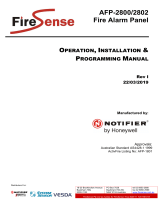
Remote Annunciator
ANNUNCIATOR DESCRIPTION
The remote annunciator is available in the following versions:
0G5719 - Remote Annunciator• has both relays and LEDs/
Keypad (RRP & RAP)
0G5720 - RRP version• - Remote Relay Panel (Relays with no
LEDs/Keypad)
0G5721 - RAP version• - Remote Annunciator Panel (LED's/
Keypad without relays J1 - J8)
The Remote Annunciator provides remote monitoring and annun-
ciation of up to 18 generator parameters using the lights/LEDs
located on the annunciator keypad. Selected generator parameters
can be annunciated using the eight Form A relays provided on
0G5719 and 0G5720.
The Remote Annunciator also provides two system-level warn-
ings which are System Ready and Communications OK. Multiple
annunciators can also be connected to obtain remote monitor-
ing and annunciation of all 18 generator parameters. Power to
the remote annunciator is supplied from the generator battery
(+12VDC or +24VDC).
Communication with the Remote Annunciator is via a RS485 serial
data link. The remote annunciator is typically configured for listen
only mode (also called slave or passive mode). In this operat-
ing mode, the annunciator receives information on the generator
status, from the generator controller and activates/deactivates the
relay outputs to reflect the status of up to eight selected generator
parameters. The remote annunciator can also be configured to
request status information from the generator (called master or
active mode).
The specific faults to be annunciated using the relay outputs (J1
- J8) can be selected using either the DIP switches located on the
annunciator printed circuit board, or the Graphical User Interface
(GUI) available using a computer via the RS232 connector on the
annunciator printed circuit board (see Figure 2).
Relays J1 - J8 provides a set of normally open contacts. All relays
are energized (contacts closed) when power is applied to the
annunciator. The relay selected to annunciate a particular fault will
then open during a fault.
The terminal block connections (J10), used to connect the battery
supply and the RS485 communication lines to the remote annun-
ciator are shown in Figure 1. The location of DIP switches S1, S2,
S3 and S4 and the RS232 connector are shown in Figure 2.
Figure 1 — Connector J10
GND Shield
Screen RS485 Data
Annunciator Description ..........Inside Font Cover
Detailed Specifications ........................................ 1
Environmental Specifications ...............................................1
Power Supply Requirements ................................................1
Communication With Generator Control System ...................1
Relay Outputs (J1 - J8) - 0G5719 & 0G5720 Only...............1
Alarm Relay Output (J9) ......................................................1
Transportation and Storage ..................................................1
Installation and Mounting ....................................2
Relay Annunciation (J1 - J8) ................................ 2
Parameter Selection Examples .............................................3
Parameters S1.1 - S1.10 & S2.1 - S2.3...............................3
Parameter "Generator Run" ..................................................4
Parameter "Generator Power" ...............................................4
Parameter "Line Power" .......................................................4
Parameter "Battery Charger AC Failure" ................................4
Generator Stop Indicators ................................... 4
Warning Indicators ...............................................4
Spare Indicator ..................................................... 5
System Status Indicators .....................................5
System Ready .....................................................................5
Communication OK .............................................................5
System Keypad Switches ..................................... 5
Test Switch .........................................................................5
Re-arm Horn Switch ............................................................5
Reset Switch .......................................................................5
Spare Keypad Switch ..........................................................6
Other Functions ..............................................................6
Graphical User Interface (GUI) or DIP Switches Enabled
- DIP Switch S3-1 ..............................................................6
Master/Slave Mode - DIP Switch S3-3 .................................6
Spare Keypad Switch - DIP Switch S3-4 ..............................6
Baud Rate Selection (DIP Switch S4) ...................................6
Alarm Relay (J9) .................................................................7
RS485 Line Termination Resistor .........................................7
Graphical User Interface (GUI) .............................................7
RS485 Communications ......................................................7
Serial Interface ....................................................................7
Communications Connect Time ...........................................7
Error Handling .....................................................................8
Limits of Operation ..............................................................8
Terminology & Abbreviations ............................... 8
Troubleshooting Guide ......................................... 9












